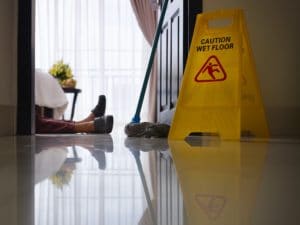Have you slipped at work or your local convenience store? If so, it may not seem like a big deal, but a slip and fall accident can be severe. According to the National Floor Safety Institute, slip and fall accidents represent 21.3% of ER visits annually.
Therefore, when you fall or trip, you need to hire an experienced personal injury lawyer to get the compensation you deserve. Although most falls aren’t fatal, the injuries you sustain can include:
• Strains and sprains
• Traumatic brain injuries
• Fractures
• Severe bruises
• Shoulder dislocation

What is a slip and fall?
In personal injury law, a slip and fall accident refers to an individual injuring themselves by slipping or tripping. A slip and fall has to occur on someone else’s property to be categorized as such. This includes a restaurant, gas station, nightclub, mall, and shopping center.
Slip and fall accidents fall under premises liability as they occur on a property maintained by someone else. The owner of the property must create a safe and healthy environment for users, and failure to do so shows negligence.
Types of slip and fall accidents
Since all personal injury cases are fact-sensitive, it’s wise to differentiate between the various types of slip and fall accidents. They include:
1. Slip and fall
These occur when a slippery liquid, object, or wetness causes the fall. For instance, slipping on milk spilt at a convenience store or beads left on the floor at an art store.
2. Step and fall
This occurs when a low spot or hole causes a fall. Although rarely used, step and fall accidents can happen. Missing steps can also fall under this category.
3. Trip and fall
This occurs when you trip over an object or an uneven surface. For instance, a raised crack on a sidewalk can cause your fall.
Causes of slip and falls
There are several causes of slips and falls, including:
• Uneven stairs and flooring
• Wet flooring
• Debris on floors
• Cracked pavement
• Inadequate lighting
• Exposed electrical wiring
• Spilled food or drink
Who is liable?
In most cases, a property owner is liable for a slip and fall injury. For instance, when you slip at a restaurant, the restaurant owner will be liable for the injuries sustained. But, at times, a third-party may be held responsible.
For example, if a contractor was responsible for the maintenance and upkeep of the restaurant, they’ll be held liable for your injuries. Similarly, you’re responsible for your safety by watching where you’re going. Don’t walk into a puddle of liquid at a grocery store or touch exposed electrical wiring.
It’s wise to consult with a personal injury lawyer to determine who is liable for your slip and fall accident. An experienced attorney can investigate your accident to identify the cause of the slip and the different factors involved.
Collecting evidence
While you can’t plan for a slip and fall accident ahead of time, there are steps you can take that ensure you receive full compensation. First, take pictures, if possible, to document your accident. Take photos of your surroundings, and spills, or objects that contributed to your fall.
Second, gather witness information from passersby that saw your fall. This can be their names and contact information. Third, fill out an accident report and ensure you get a copy. However, don’t sign anything or give a lengthy account of events.
Next, seek medical attention to prove and treat your injuries. Remember, the earlier you see a doctor, the better. Lastly, hire a personal injury lawyer to represent you as laws can be complicated. Contact Guy Levy Law today to consult with a personal injury lawyer.


